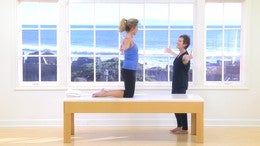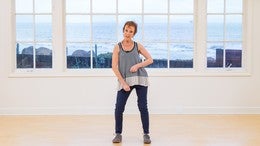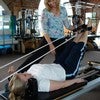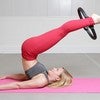Description
About This Video
Transcript
Read Full Transcript
Hi there. I'm Debra Colet here with my friend Ana. And we're going to do a series of exercises that hopefully show some of the components of a healthy extension, not only a healthy extension, but a satisfying extension. And um, so here we go. So we're going to start using the high barrel facing the barrel. Go ahead. And it's nice to have some padding down here, whatever kind of an insert you have for your barrel. So you want to be on the balls of your feet and your heels are up against the back frame, slight bend in your knee. And then just let yourself come over the barrel.
Just drape yourself over and you can keep your hands by your chest, but allow your spine to go forward. So what I want you to focus on right off the bat is the positioning and the energy and your feet. So as you push down into the balls of your feet, you want to feel the potential for some lift up the front of the body. And then as you reach your heels back away from that and down on whatever surface you're on, that starts to wake up the back of the pelvis, so going in front of the body, back of the body in front of the foot, back of the foot so that you set up right off the bat, a nice anchoring of the tail. And then here she is over the barrel. And of course the barrel is a support, but we don't want to just collapse on the barrel.
We want to consider that the shaping of the barrel itself is giving our body an imprint of support in the flexors so that we're not flattened down with nowhere to go to come up into extension. So a little bit of flection at the ankle, a little bit of flection at the knee and the barrel is providing space around the hip so that we're not at the end range when we start out. So it's a lot easier to start to explore extension over the barrel because the legs are lower than the pelvis and the angle is just going to be a lot, a lot easier. The other component that we want to work with is the relationship of the hand to the arm, to the shoulder girdle and the amount of support that people need is different in terms of how much you actually gonna use your arms. In the beginning you might use them a lot and then eventually of course you find your own internal support more and more. You can begin to take, take that away as you get into the more advanced version of the exercise. So starting by that push in the sole and the ball of your foot.
Think of stretching along the front side of your body and begin to lift your gaze and then one by one lengthening the Vertebra. It's really quite lovely pressing in through the hands to find the strength of the arm to connect into the shoulder girdle, which helps lift some of the weight of the trunk. And then when you get to this point, keep stretching through the front of your body and add the reach of the heel so that the back of your body starts to tone as well and then come forward. And the barrel is really, really nice because you get this help or encouragement to completely release the spine all the way through the neck and the head. So this is a part of the spine that's often very elusive for us.
The other thing that's really nice, although some people don't tolerate it that well, is that the barrel is actually coming up and pushing a little bit and toning into the diaphragm, the solar plexus. So let's just show that one more time. Start down at your feet. Feel that lengthening all the way up to the front of your body, breathing in, starting to come up. And then there's a certain point right where the weight of the body has to get picked up. You either have the strength without the arms or you don't, and it's not a problem if you don't, but you want to consciously use your arms to lift the shoulder girdle to pick up the rib cage. That's beautiful. And at this point, if you wanted to, why don't you keep your gay straight forward? You can play with taking the hands off or not.
I mean you'd think it's pretty simple, but it's not actually right to actually lift those hands off. It really shows you how much of the support through the lower body it requires. Right up through the, so as into the trunk. And then put your hands down for a second and come on back down. So we can take that into arm circles. Breathing in, inhaling here, we're going to lengthen out through the top of the head and I'm going to bring in another little awareness that is the skull starts to come around, so does the tail. So it's a beautiful balance.
You see to the degree that the head comes up, the tail goes down so that we don't want to just clunk technical term into the back of the neck, but you know, you start to actually pay attention to the timing of the reaching of the back of the skull with the curling of the tail. So now you could reach your arms forward and practice that range in your shoulders. Circle around. And if you can reach all the way to the back of the ladder barrel, that's kind of Nice. You can hold the top, you can hold wider if you want. And then here, avoid pulling down into the lumbar spine. So maybe push up through your legs even more to get even more lift and just breathe. Release the arms. Takes a lot of strength.
Beautiful. Circle around. At this point, if you wanted to, you could put your hands down if you're nervous or you can just take the whole shape and float yourself over. So that's beautiful and you can just see that beautiful connection of the shoulder girdle reaching all the way into the hands. Okay, that was great. So now go ahead and just bring your hands up onto the barrel. We're going to move up onto the actual rum. So go ahead and step up onto the wrung. What's tricky here, a lot of us are quads are tight, so there's a tendency to get stuck in the barrel.
So you want to make sure that your barrel is at a, is opened up to the point where you feel like you have enough room but not so much room that you're going to slide down all the time. You want to feel that brace. Okay? You want to feel a little bit braced, reach your heels back for a second between the rungs and the actual ladder barrel itself. When you go into more extension, in other words, as you come back a little further, it's okay to let these heels come off to give you a little bit more play in your hip, right? So just kind of rock back and forth and you can feel that as you go forward. It helps to push your heels back and as you go back it helps to have a little bit more room. Okay. So there you have that. And what we're going to do now is an exercise called the dolphin to just get going into the spinal wave. Okay?
So using the strength of your arms to help hold the weight of your body, not losing sight of your feet, right? So press through the ball, the foot to lift the front with the heel up and back to find the connection through the back line of your body. And then you dive. So you do a little fetal curve curve forward. And then you lengthen the head and tail away from one another and come back up. Beautiful. And you can go a little faster. So the arms are there to help hold the weight of your body to the degree that you need it to.
Find the fluidity in the freedom through the spine and again and again, making sure that you're going longer and less compressive through the lumbar. So as your head comes up, your tail goes down and now reverse it out. You go push through the arms, curl yourself up, and there you go. Breathe in and breathe out. So we're getting a beautiful wave like action through the spine at the same time. We're building in the patterning, the imprint of the push of the ball of the foot to lift the front of the body.
And what I would do for you on a is I would think of a little bit of internal rotation at the hip to bring the thighs a little bit more directly up into the pelvis because that's going to keep you from so much compression in your lower back. I know that's hard for you to feel, but maybe don't make your movement as big. Okay. Maybe do a couple more and tell me if you actually feel better, less turned out, less wide in the thigh. It is better because your, your line of force is more direct. Okay. Very, very nice. Now you're going to go ahead and step off and turn around and we're just going to stretch the quads in the front of the ankle out a little bit. So take one of your feet up onto the, onto the barrel. Do your best to level off. There's a tendency to sit into the standing leg. So we're going to not do that. Okay. So really feel the, again, I can adjust this pad. In this situation, we don't really have enough link for her foot, so I'm just going to move it out a little bit. Okay, so here it is again, right?
The ball, the foot, and then the doming or the lifting of the arch. And then the reaching down through the heel. Try not to highbrow, extend the knee, but really keep that Tibia forward right into that ankle and then reaching the femur back up into the pelvis as opposed to pushing the shinbone back. Okay? Very good. Now sometimes what happens when you do this as your hamstring cramps up. So that's unfortunate, but it just goes to show often how tight our quads are.
And this is a pretty tight position, but it's important. So we're gonna shift into our center line so we're not sitting out into what we'd call the standing hip. And then use the pressure literally of the barrel onto your foot to start to stretch out the toes, stretch out the, the, uh, the front of the ankle. Okay. And then do your best to let your knee release down. Actually, what's really nice to do here, what also be a side bend? So we're improvising now. I would take my right arm up and feel the power of this outer hip. Here's our sideline again. Okay.
Stretching over and over and just reach, reach, reach, reach, reach, reach, reach, reach longer. No specialists, curves, just lung, just straight, not this way. Just go for length there. That's beautiful. It feels good though, doesn't it? Yeah. And then come back. Okay. So we're going to take that foot down and do the other side. Good. All right. So what we're interested in here, as best as we can is getting, uh, a balance of pressure across the entire front of the foot, the ankle, not sitting into the standing leg, hip. You feel that in your quad as a stretch on, do that? Yes. Not really. Not so much. What would happen if I took you a little farther forward and you pressed more on your foot? Yeah. So you don't want to sit back.
You want to get right on top of the standing leg. Okay. Go ahead and do your side bend. Take the left arm up and over. You go over, you go over, you go. Nice. And then come back. Okay, great. So turn around. We're going to do one full swan on here. Go ahead and come up onto the balls of your feet.
Heels together again, think a little bit more about that internal. Yeah, right at the hip. It's not that you knock your sizes, it's just right here at the hip. Okay. And then with regard to your size, let them corkscrew into the support of your pelvis. Okay. So go ahead and drape yourself over the barrel. Reach your arms by your ears, palms up. And here we go. So breathing in, press off the ball of your foot. Reach up, exhale into your t. Now feel the push off the ball of the foot to help you come forward.
And then as you go back into your second bend, allow your hails to lift a little so that the more your head goes back, the more the tail comes down. How about that? Now lift up, press your heels into the wood to give you the power. Pull the hips back just a tad and release over the barrel. And that was perfect. So I think we'll just stop right there. We're going to move on to the mat now. So now we moved to the Mat and uh, you can see that I've got this towel rolled up under on his hips in. You have to kind of play with the, the amount that you use. Um, some of you have probably seen a whole quarter bower or a half barrel, anything like that. But the idea that we're working with here is that the mat, it may be a simple place to do the swan, but it's not necessarily an easy place to find that freedom of extension because for a lot of us, if the quads are tight and the hip flexors are tight and low back the ankles, then when you lie flat on your belly like this, the floor comes up to meet you and you're sort of stuck at the end range of your extension. You don't have anywhere to go. And so for most of us, when we tell ourselves, okay, come up into swan, there's really nothing else to do except hyper extend the lumbar spine or overcrank back on our neck, neither of which we want to do.
So what I'm trying to show here is a teeny bit leftover of what you get on the barrel, which is that the barrel, if you remember, gave her that space to flex her hips over. Um, the other thing of course is that the front of the ankles may be tight. And so that's pushing her into her lower back instead of being able to really get the tops of the feet and into the Shin to help anchor the sitz bones and the tail. So it's, it's kind of a balancing act, right? If the quads are tight and the ankle, the front of the body's tight and it's pulling her down and then she tries to tell herself, no, I want to be able to come up and back. Then you're at cross purposes with yourself. So, um, you can use something under the pelvis like this to afford some space.
Another thing of course you could do would be to take your feet off the back edge of the mat and all of that is just designed to help the leverage a little bit. Okay. So now I would like to do is just go through a little bit of the spinal wave on here. Breathing in. Go ahead and curl your nose to your navel and feel your navel pulling your pubic bone. Excuse me. Pulling up towards your navel. So nose to naval, pubic bone to navel. And here's where it's nice as you go the other way, reach your nose from your naval and reach your pubic bone away from your naval. I know it's just a cue, it's just a thought, but it maintains that length. And then again, curl over, nose to naval, pubic bone to naval.
And what I'm looking at by saying pubic bone away from naval is to just work with the tendency to collapse immediately into the lower, into the lumbar spine. Right? But instead getting the length first curl and then release the other way. And it feels very good, doesn't it? Okay, so we're going to add a little something for the opening of the thigh, which is to do the curl nose to naval pubic bone to navel. Now as you begin to reach your pubic bone away from your naval and you begin to look up, bend your knees, bend the knees, no, no, like literally put your feet up.
So what's happening now is she's got that little bit of towel to rock on. Do you feel that so that you actually get the release into the front of the hip as opposed to just dumping, if you will, into the lumbar spine. And the tighter your low back is, the farther forward you can bring your arms so that you're not asking as much of yourself and now curl into it and feel how is the pubic bone comes toward the belly. You can lengthen your thighs away from that stretch of the belly. Right? And then come up again and let it, yes, and that's beautiful. You could see how she self-corrected the initial thought was to just not thought, but the initial habit was to just go into the Lumbar, but now she can really feel like that's giving her the feedback of getting the movement around the hip joint, which is hard for us. Isn't that beautiful?
Okay. Good job. So that's what I call the spinal wave. All right, so now we're going to, I'm going to get rid of this. Stay up on your forearms if you don't mind. Come up onto one of them. Okay. So you're going to balance on this forearm and now reach back and take hold of the top of your foot and what you want to do is if they can't reach, you can get a strap, but we'd like to have your fingers pointing backwards. This is not so much fun for some of us.
You allow the shoulder to come up, but you see we're trying to get that same bend in the foot. That's part and parcel of the whole complex of the foot, the ankle, the knee, the hip. Okay, that's really, really great and it's a huge stretch for the quad. Would you say? Now you know it's hard to hold yourself up on this forearm, but that's part of the strength hand, forearm, shoulder girdle, torso. You know what I mean? It's all part of it. Everything. Everything is important and you're going to find that if you work at this way, don't force the heel to the button, let it be a little on the outside and also don't force the knees together. This changes over time. It really does.
You can roll a little side to side. That is kind of a pain pleasure sort of, right? Combination of things. Yeah. All right. That's really, really good. Now carefully let that go. Sometimes the toes have now cramped, so and then we'll do the other side. Don't you think one of the hardest parts of this is just holding yourself up on your forearm. I know, but you need the strength in your upper body to do good extension. Okay, so now come around, grab a hold. So this is also interesting, right? I mean if the foot doesn't want to bend, then the Tibia is restricted from its journey down into the front of the ankle, right? Which then lightens the load on the knee, right? Yes.
And then that's high. So there's all like, it's all connected so you can roll a little bit side to side. She's, you're fine, right? Yes. Different on this side always. Right. So you're your own, your own foam roller. Okay, now release. Okay. And then come, just come into that same position with your forearms and start to think of pulling yourself less neck. Okay. Just think of pulling yourself forward. And don't you feel like you actually have more space in your hip. So that's a beautiful thing. So let's just try a regular old Swan. Okay. So bring your hands back by your chest.
Here we are kind of pretending we're still over the barrel, right? So we're going to Tuck the chin way up into the throat. Gently pressing the forehead down. Why? To get a little, you don't have to exaggerate, but just to get a little of that flexor support. So even though, yeah, we know we're coming into extension, but we want to train ourselves right off the bat, not to collapse through the shoulder or the shoulder girl, you know, and like fall into our extension. So right away we make these connections. So press through the palm, start to lengthen out through the top of the head.
Take that breath, let the breath lift and roll your collarbones. And then there's this moment where you gotta use your arms, right? And that's okay. Let the strength of your arms help lift this. And that's really great. And for you it's really important not to just keep going back through the neck, but feel a little letting go through the, yeah, that's it. Get your tail to curl to. Yes.
You feel that? And then pick the weight of yourself up as if the barrel we're here, right? You have to, sorry. Lengthen yourself all the way over and then curl. So again, what we're going to like if you were to practice this and then over time come back to it, you really start to feel go again and more and more that you can get the hip open. That space goes long. Then you don't have to grip your butts so much and you can actually get the tail relative to the head. So what if we do one more showing what? The towel?
Just for the heck of it, right? And then you're going to really enjoy it. So we're going to roll the towel up. Why don't you just put it, I don't know how thick you want it right below the, the crests of the pelvic bones. You don't want to skip the movement through the femoral joint, right? You don't want to jump from the low back just into the quads. And so you start to feel, oh yeah, there's, there's a part of me that I still have to move through.
And if it's too tough in the beginning, we make these modifications to help you actually feel those relationships. Check it out though. Look at her feet. Look how much more down they are than when we started. That's very nice. Okay, so you start with that sense of the spinal wave. You're kind of curled into yourself like the dolphin, right? It gives you that support and then you're gonna start to lengthen out.
Keep going longer and longer. Let yourself rely on the towel a little. Wow. That is so nice. Keep stretching up, see if you can actually find your feet. Press with them. All right, that's great. And then over you go and let yourself rest. That was beautiful. Thank you. So you can see where this might go with regard to all the different parts.
If you were going to take it into a larger swan dive or even the rocking exercise, you know, reaching back for the feet, all the patterns, the patterns are there, and um, when you actually are conscious of what the patterns are that you're looking for and you begin to imprint them into your body from the get go, then reaching for the more advanced exercises is just not, it's not, it's not such a leap. It's just, it's just an evolution. It's just much more of a natural progression.
Comments
You need to be a subscriber to post a comment.
Please Log In or Create an Account to start your free trial.



















